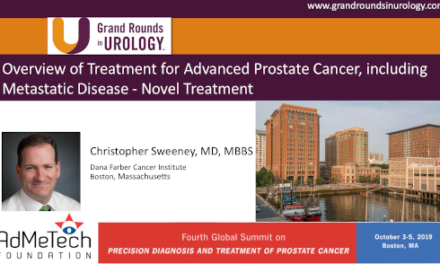Dr. M. Scott Lucia presented “The “Who’s” of Genomic Markers: Who to Re-Biopsy” at the 27th annual International Prostate Cancer Update meeting on Wednesday, January 25, 2017.
Keywords: prostate cancer, re-biopsy, methylation, genomic markers
How to cite: Lucia, M. Scott. “The “Who’s” of Genomic Markers: Who to Re-Biopsy”. January 25, 2017. Accessed Jun 2025. https://grandroundsinurology.com/whos-genomic-markers-re-biopsy
Transcript
The “Who’s” of Genomic Markers: Who to Re-Biopsy
I’m going to be talking about the who to re-biopsy market here. And why are we even talking about this particular thing? Well, here’s by way of disclosure, I do work on the advisory board for Genomic Health, but I’m not talking about their marker when I talk today. The reality is that over a million biopsies are performed in this country every year, and only about 25% of them on average are diagnosed with prostate cancer, leaving the vast majority being negative for prostate cancer. However, we know because of sampling issues with needle biopsies in the prostate that a negative biopsy does not really necessarily mean no cancer. Studies have shown that the prostate biopsy is really somewhere between 50% and 85% sensitive. So if you do repeat biopsies and if look at big databases, like CAPTURE database, and if you do repeat biopsies on most of these men, again, about 25% of them will have cancer. So the majority of repeat biopsies are again negative. So it puts you in this quandary, this is sort of PSA purgatory, if you will, where you don’t know if you’ve got really a true negative test that if you perform repeat biopsies could increase your risk of complications, or if you just missed a cancer as a false negative, and if you ignore that, that that cancer could progress and you’ll miss your window of opportunity, particularly if it’s a high-grade cancer, for curative treatment. So what I want to talk about today, as a pathologist we see these negative biopsies, and it’s in our best interest to pull out the maximum amount of information from these needle biopsies as we can. Despite the fact that in a 12-core biopsy you’re sampling less than 1% of the prostate, is there information there at the prostate level that will lead you to believe that there’s an increased risk for the person to have cancer, and that’s what I want to talk about.
Certainly, we can look at pathologic findings on biopsies, and I’ll just touch this a little bit. These haven’t gone away, things like high-grade prostatic intraepithelial neoplasia (PIN) and atypia, or atypical small acinar proliferation (ASAP) have not gone away, but what is added to this regimen now are the genomic markers, and we’re going to talk about a couple of them, DNA methylation and the Prostate Core Mitomic Test (PCMT). Let’s start up here look at pathologic findings on biopsy.
Looking at large databases, about 11% of biopsies are diagnosed with isolated high-grade prostatic intraepithelial neoplasia. And on average about 5% of biopsies so-called atypia or ASAP. Let’s really define what we’re talking about here when we look at these. When we talk about atypia and ASAP you’re talking about architecturally abnormal glands that lack a sufficient pathologic criteria to knee-jerk them as cancer, sometimes because there’s too few glands associated with them, sometimes because they don’t have a lot of cytologic atypia. So there is a certain level of comfort of the pathologists looking at the case on whether or not he diagnoses ASAP or not. And although it’s about 5% across the country, my experience in our institution is it’s more like 1% of cases. However, you have to realize that it is not an entity per say, ASAP is really saying I don’t know. I see something abnormal but I’m not sure if it’s cancer. So if you go back and look at who has been re-biopsied in those situations, and here’s a number of studies that have looked at this, you see that anywhere from about a third to 50% of the time when you re-biopsy you find cancer. So if you’re really looking at something that’s under sampled cancer, this is not surprising. So weighted average here is about 40%. So it is still a good indication for re-biopsy.
Well what about PIN? PIN less cell, if you look at large major studies here you see that the weighted average is only about a fifth of the time. If you re-biopsy them you’ll find cancer on repeat biopsy. So it’s kind of fallen out of favor. In fact, what we saw in the prostate cancer PREVENTION trials, if you just re-biopsy everybody, all the people that we re-biopsied in the setting of having a negative biopsy during that trial, we found about 15% of them were diagnosed with cancer. So it’s just a little bit better than just if you re-biopsied everything. However, more recent data has suggested that there may be a difference in the amount of PIN that you see. This one study. This happens to be a Korean study, but it was a well-designed study, and it was a large volume study, looking at patients who had been re-biopsied after a negative biopsy. And if you just biopsied and had benign tissue without PIN or ASAP, again, about almost 15% of them would have cancer on re-biopsy. PIN was just a little bit better as a total, but if you look, if they only had one focus of PIN, one core, it was about the same as benign. But if you had two more, multiplicity, suggesting a wider field effect that that doubled. And it was almost as great as their ASAP rate upon re-biopsy.
But it’s still, when you look at these data you see very clear that of the negative biopsies 85% or more of them don’t show these features, don’t show high-grade PIN, don’t show ASAP. So what do we do with those? And that’s where the genomic markers are here to help us in this setting. And I want to talk about two of them that have made it to commercialization, DNA methylation, which is the ConfirmMDx study, and the Prostate Core Mitomic Test, which is fairly recent, a lot less known about that, but I’ll touch a little bit upon that.
The idea here is that there a field effect that occurs in prostate. It may antedate or it may subsequently occur with prostate cancer, we don’t know for sure, but there’s a widespread phenomena that in benign tissue there are functional changes that are below the resolution of the microscope, and that these can be picked up if you have the right test. And if you look at DNA methylation it’s one such candidate for here. What are we talking about? This is an enzyme-induced methylation of specific areas of promotor regions of genes. It’s a widespread phenomena, it occurs in cancer, not just prostate cancer, but a lot of cancers have this expression. And what it does is it blocks protein expression. So it may be some of the earliest changes that you see in prostate cancer. The interesting thing about its field effect has been demonstrated, for instance, in this study out the University of Wisconsin. What they looked at is methylation of a number of genes in prostates that were not associated with tumor. This would be non-tumor associated prostate tissues, and those prostatectomy specimens that contain tumor in which they not only looked at the tumor, but they looked at adjacent normal, or even normal tissue at some distance from the tumor, up to a centimeter away. And what they showed, these are a number of different genes that showed methylation. And they showed that compared to normal that cancer certainly had either increased or decreased methylation, you can have hypomethylation as well. And if you look at these non-tumor tissues that were some distance away, that they also had increased methylation when compared to normal. Not the same height at the cancer, but elevated nonetheless. Suggesting that this field effect can be seen at some distance from the cancer.
Now the ConfirmMDx assay is a commercialized version of this, looking at a multiplexed, a three-gene multiplex panel. The three genes are GSTP1, which is an antioxidant protein, and two tumor suppressor genes, APC and RASSF1. These are multiplexed in a methylation specific PCR reaction. So you’re looking for things within this window right here that you can mark as positive for the test. To be a positive test suggests that you have increased methylation of any one of those three genes in at least one core when you test all the negative cores in the prostate. This is one of the first real good prospective studies done out of Europe, multi-center site which they had 483 men with initial negative biopsy were analyzed using the ConfirmMDx test, and followed by re-biopsy within 30 months. And as you can see here in a multi-varied analysis, the ConfirmMDx test had the highest odds ratio when compared to the things I’ve talked about, atypia, high-grade PIN, and of course PSA and age. So it was the best indicator. And this study, abnormal DRE also was important.
But here’s an important aspect, here’s the actual study assay performance characteristics, the sensitivity, specificity you see here, but this was powered for negative predictive value. So giving a negative predictive value of 90% is important, because if you’re going to use this test to decide who not to re-biopsy you want to be comforted that you’re not missing cancer here, and so you want to power it strongly for negative predictive value. This was followed up by United States multi-institutional study, the DOCUMENT study, a validation study that again looked at 320. This was a retrospective study looking at men who had had two consecutive either negative biopsies, which control, versus those who were subsequently found to be positive. And again, the DNA methylation out performed all the things I’ve been talking about, PIN and atypia in terms of predicting who was going to have cancer on biopsy. And there’s the area under the curve, 628, and again, the negative predictive value was high at 88%.
The interesting thing about this, reflecting on what Dr. Crawford said earlier, do we just want to find all cancer, or do we really want to focus on those cancers that are likely to be aggressive, high-grade cancers? And there’s some data that suggests that quantification, or semi-quantification at least of the degree of methylation could aid in this. And this is a study looking at predicting high-grade disease, defined as Gleason score 7 or above, using a semi-quantitative approach to the methylation. How many genes were methylated over how many cores. And that’s combined methylation events over all cores into what’s called EpiScore, and that’s in yellow here or in blue here. You can see this area under the curve, out performs things like PSA and something near and dear to my heart, the Prostate Cancer Prevention Trial Risk Calculator, which is this line right here. And you can see that even if you combine the EpiScore with other things like DRE status, atypia, high-grade PIN that there wasn’t that—a mild increase in the area under the curve, but by far the most important thing was the EpiScore. And over here you can see that it out performs all the other factors in multivariant analysis. A DNA quantification of methylation may be important.
And what about the Prostate Core Mitomic test? A lot less is known about this. This came out of Canada, by Genesis Genomics. This is, again, a PCR-based assay, and again looks at DNA isolated from negative prostate biopsies. The difference here is you’re looking at mitochondrial DNA alterations. And very common deletion, a 3.4 kilobase deletion that occurs here in DNA has been identified in prostate cancer, and also has been interestingly found to be a field effect in adjacent benign tissue.
Looking at this, again, taking negative cores from men who had re-biopsy outcomes, they did a small study of 100 men of which 20% of them showed cancer on repeat biopsy, again, using thresholding of the PCR where you’re more likely to have prostate cancer down here, and less likely to have prostate cancer on higher cycle thresholding. They found a threshold of 31 cycles, again, maximized their negative predictive value, here 91% with a reasonable area under the curve here, it’s been smoothed, but area under the curve for predicting prostate cancer. Now, notice the data, the study, this was a 2010 study and we haven’t really seen a good follow-up study, and we need a larger validation study for this before this can really make its way, and I haven’t seen that yet, so it’s availability is still questionable right here.
So where are we going with this? I think the latest version of the National Comprehensive Cancer Network (NCCN) guidelines really makes a good summary slide of what I’ve just talked about here. If you have atypia on a biopsy then it’s probably indicative that you should re-biopsy again. What about high-grade PIN? Well, if it’s multifocal, two or ore sites, probably you should be in this bin as well as the atypia. If it’s focal, probably should be down here with the benign. What do we do here? Do we just follow PSA, do we just do this again annually and follow into our PSA purgatory, or do we add some other things? And for the first time we’re starting to see recommendations in which you should use some of the tissue. We have the tissue in front of us. These other things I didn’t talk about today, 4Kscore, Phi, those other things that Dr. Crawford mentioned today, because they’re not really looking at the tissue level. And here you have the tissue with the negative biopsy, why don’t we glean as much information from that tissue as possible. And that’s where you can come into ConfirmMDx, that can then give you information about your risk and guide decisions on repeat biopsy.
So, to summarize this, trust guided biopsies may miss significant cancers. We know this, so there’s uncertainty as to cancer status, and a likelihood for repeat biopsy. But many repeat biopsies may be unnecessary, resulting in increased risk. Benign tissue may harbor malignancy associated changes that are not recognized under the microscope. So we can glean that information from a molecular biomarker such as the ConfirmMDx to help us improve patient selection of who needs repeat biopsy and reduce unnecessary biopsies. Thank you.
ABOUT THE AUTHOR
M. Scott Lucia, MD, is Professor and Vice Chair of the Department of Pathology and Director of Anatomic Pathology and of the Prostate Diagnostic Laboratory at the University of Colorado Anschutz Medical Campus (UCAMC) School of Medicine. He also serves as the Director of the Prostate Cancer Research Laboratories at UCAMC and of the UCAMC Biorepository Core Facility. Dr. Lucia received his MD from the University of Colorado School of Medicine in 1988. He completed his internship and residency in pathology at the University of Colorado in 1993. He was a research fellow in the Laboratory of Chemoprevention at the National Institutes of Health from 1993 to 1995, before returning to the University of Colorado in 1995.
Dr. Lucia served as the primary pathologist for the Prostate Cancer Prevention Trial (PCPT) and Vitamin E and Selenium Chemoprevention Trial (SELECT), sponsored by the Southwest Oncology Group; the Medical Therapy of Prostate Symptoms (MTOPS) trial, sponsored by the NIDDK; and the Reduction with Dutasteride of Clinical Progression Events in Expectant Management of Prostate Cancer (REDEEM), sponsored by GlaxoSmithKline. He directs the operation of several tissue and serum biorepositories for prostate and prostatic diseases, including those for the PCPT, MTOPS, SELECT, and the University of Colorado Cancer Center Prostate Biorepository. He has authored or co-authored over 180 peer-reviewed articles, reviews, editorials, and book chapters. His primary areas of interest include pathology of prostate cancer and hyperplasia, early detection and prevention of prostate cancer, prostate cancer biomarkers, and mechanisms of carcinogenesis.




